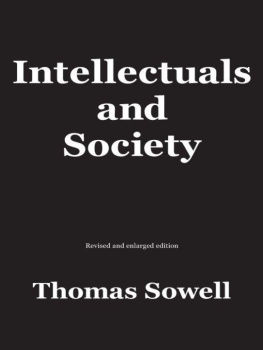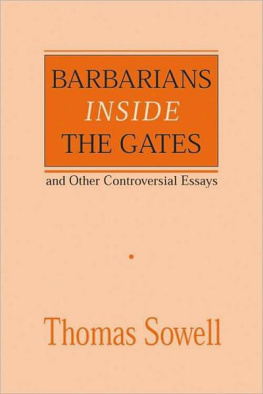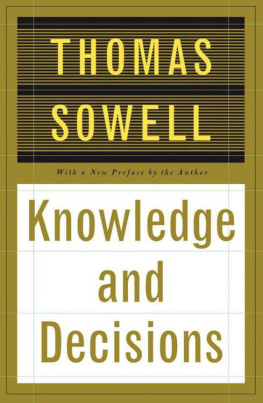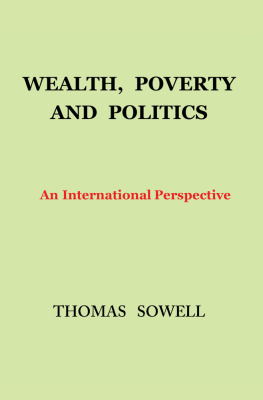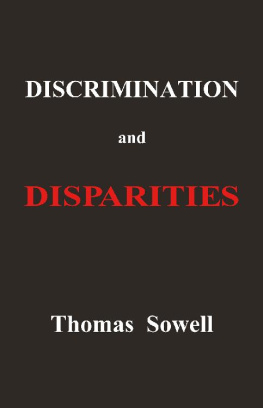Table of Contents
RELATED BOOKS BY THE SAME AUTHOR
The Vision of the Anointed
The Quest for Cosmic Justice
Knowledge and Decisions
On Classical Economics
To my wife Mary, with love
Every man, wherever he goes, is encompassed by a cloud of comforting convictions, which move with him like flies on a summer day.
Bertrand Russell
Preface to the 2006 Edition
T his is a revised edition of my own favorite among the books I have writtenmainly because it addresses a fundamental question that seldom gets the attention it deserves: What are the underlying assumptions behind the very different ideological visions of the world being contested in modern times? The purpose here will not be to determine which of these visions is more valid but rather to reveal the inherent logic behind each of these sets of views and the ramifications of their assumptions which lead not only to different conclusions on particular issues but also to wholly different meanings to such fundamental words as justice, equality, and power. Although this is in one sense a book about the history of ideas, it is also very much about our own times, for this conflict of visions is as sharply contested today as it has been over the past two centuries.
Two other books of mine do seek to examine the validity of different visions The Vision of the Anointed and The Quest for Cosmic Justice but that is not the task in A Conflict of Visions . Together these three books might be considered an informal trilogy, though each was written to stand alone. However, I cannot claim to have stood alone when preparing this revised edition, for my two assistants Na Liu and Elizabeth Costa have made major contributions in ferreting out errors and inconsistencies and in preparing the computerized work for publication.
Thomas Sowell
The Hoover Institution
Stanford University
Preface to the 1987 Edition
A conflict of visions differs from a conflict between contending interests. When interests are at stake, the parties directly affected usually understand clearly what the issue is and what they individually stand to gain or lose. The general public may not understandand indeed may be confused precisely because of the propaganda of the contending parties. But such public confusion is the direct consequence of the clarity of the interested parties themselves. However, when there is a conflict of visions, those most powerfully affected by a particular vision may be the least aware of its underlying assumptionsor the least interested in stopping to examine such theoretical questions when there are urgent practical issues to be confronted, crusades to be launched, or values to be defended at all costs.
Yet visions are not mere emotional drives. On the contrary, they have a remarkable logical consistency, even if those devoted to these visions have seldom investigated that logic. Nor are visions confined to zealots and ideologues. We all have visions. They are the silent shapers of our thoughts.
Visions may be moral, political, economic, religious, or social. In these or other realms, we sacrifice for our visions and sometimes, if need be, face ruin rather than betray them. Where visions conflict irreconcilably, whole societies may be torn apart. Conflicts of interests dominate the short run, but conflicts of visions dominate history.
We will do almost anything for our visions, except think about them. The purpose of this book is to think about them.
Thomas Sowell
The Hoover Institution
Stanford University
PART I:
PATTERNS
Chapter 1
The Role of Visions
O ne of the curious things about political opinions is how often the same people line up on opposite sides of different issues. The issues themselves may have no intrinsic connection with each other. They may range from military spending to drug laws to monetary policy to education. Yet the same familiar faces can be found glaring at each other from opposite sides of the political fence, again and again. It happens too often to be coincidence and it is too uncontrolled to be a plot. A closer look at the arguments on both sides often shows that they are reasoning from fundamentally different premises. These different premisesoften implicitare what provide the consistency behind the repeated opposition of individuals and groups on numerous, unrelated issues. They have different visions of how the world works.
It would be good to be able to say that we should dispense with visions entirely, and deal only with reality. But that may be the most utopian vision of all. Reality is far too complex to be comprehended by any given mind. Visions are like maps that guide us through a tangle of bewildering complexities. Like maps, visions have to leave out many concrete features in order to enable us to focus on a few key paths to our goals. Visions are indispensablebut dangerous, precisely to the extent that we confuse them with reality itself. What has been deliberately neglected may not in fact turn out to be negligible in its effect on the results. That has to be tested against evidence.
A vision has been described as a pre-analytic cognitive act. It is what we sense or feel before we have constructed any systematic reasoning that could be called a theory, much less deduced any specific consequences as hypotheses to be tested against evidence. A vision is our sense of how the world works. For example, primitive mans sense of why leaves move may have been that some spirit moves them, and his sense of why tides rise or volcanoes erupt may have run along similar lines. Newton had a very different vision of how the world works and Einstein still another. For social phenomena, Rousseau had a very different vision of human causation from that of Edmund Burke.
Visions are the foundations on which theories are built. The final structure depends not only on the foundation, but also on how carefully and consistently the framework of theory is constructed and how well buttressed it is with hard facts. Visions are very subjective, but well-constructed theories have clear implications, and facts can test and measure their objective validity. The world learned at Hiroshima that Einsteins vision of physics was not just Einsteins vision.
Logic is an essential ingredient in the process of turning a vision into a theory, just as empirical evidence is then essential for determining the validity of that theory. But it is the initial vision which is crucial for our glimpse of insight into the way the world works. In Paretos words:
Logic is useful for proof but almost never for making discoveries. A man receives certain impressions; under their influence he stateswithout being able to say either how or why, and if he attempts to do so he deceives himselfa proposition, which can be verified experimentally....
Visions are all, to some extent, simplisticthough that is a term usually reserved for other peoples visions, not our own. The ever-changing kaleidoscope of raw reality would defeat the human mind by its complexity, except for the minds ability to abstract, to pick out parts and think of them as the whole. This is nowhere more necessary than in social visions and social theory, dealing with the complex and often subconscious interactions of millions of human beings.
No matter what vision we build on, it will never account for every sparrows fall. Social visions especially must leave many important phenomena unexplained, or explained only in ad hoc fashion, or by inconsistent assumptions that derive from more than one vision. The purest vision may not be the basis of the most impressive theories, much less the most valid ones. Yet purer visions may be more revealing as to unspoken premises than are the more complex theories. For purposes of understanding the role of visions, William Godwins Enquiry Concerning Political Justice (1793) may tell us more than Marxs Capital . Indeed, we may understand more of Marxs Capital after we have seen how similar premises worked out in the less complicated model of William Godwin. Likewise, the vision of social causation underlying the theories of the Physiocrats was in its essentials very much like the vision elaborated in a more complex and sophisticated way by Adam Smith and still later (and still more so) by Milton Friedman.


